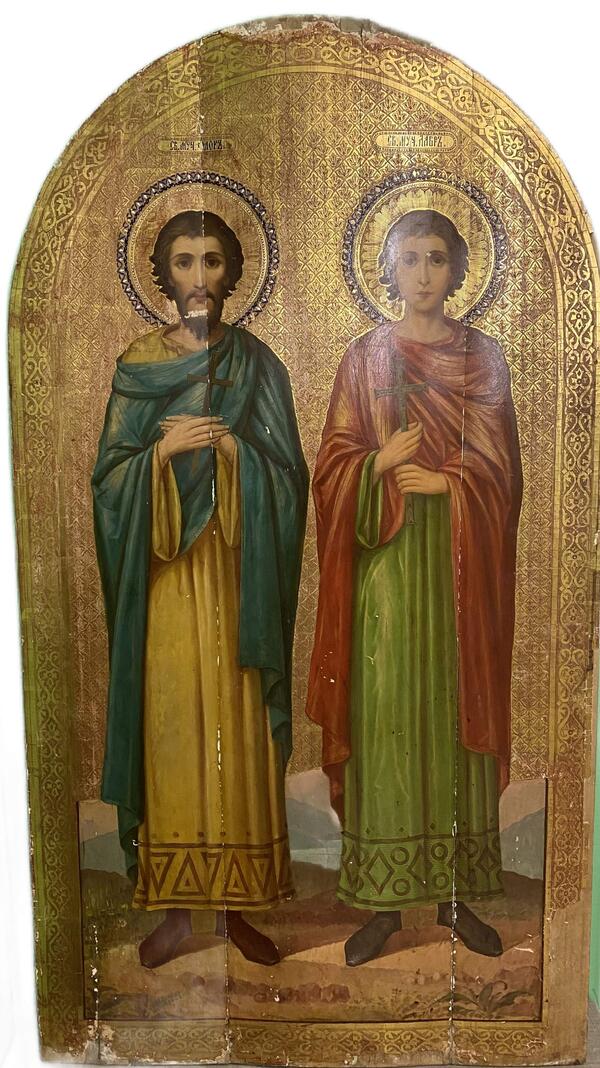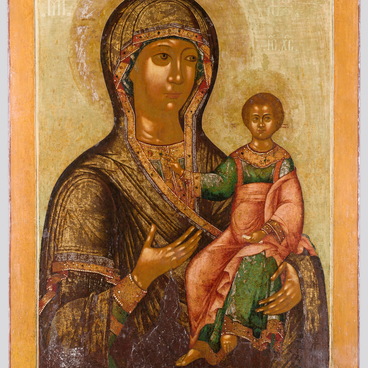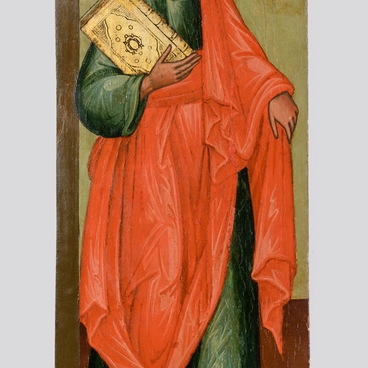The holy brothers Florus and Laurus were revered in Rus as heavenly patrons of livestock, primarily horses. Their icons were always kept in every peasant house. According to Archimandrite Macarius (Mirolyubov), in the 16th — early 17th century, the heated church of Florus and Laurus stood “under the Balakhna fortress, 16 sazhens from it” (1 sazhen was equal to 7ft). The icon of the martyrs housed there was later mentioned in the 1832 inventory of valuable artifacts from the Church of the Nativity of the Most Holy Theotokos.
The saints were born in the 2nd century in Byzantium and were stonemasons. From their teachers, the pious Proclus and Maximus, they both learned not only the craft, but also the rules of a godly life.
When Maximus and Proclus were subjected to sufferings for the Christian faith, Saints Florus and Laurus moved to the province of Illyricum. There, when people learned about their skills, the brothers were called by the son of the Empress, Likaion, and ordered to build a large temple in honor of Hercules. Having agreed, they gave away the money they received to beggars and spent their days at the construction site, and their nights in prayer.
During that time, they converted many poor people to Christianity and even the pagan priest Merentius (his Christian name later became Alexander), whose son was wounded by a stone, but healed by the prayers of the saints. With God’s help, the temple was quickly built, and at night, with the help of newly converted Christians, Florus and Laurus destroyed all pagan idols and installed a cross in the eastern part of the temple. Seeing the Christian church, Likaion ordered to kill all Christians who were there. The holy brothers-builders were thrown into a well and covered with earth, but their souls were immediately carried away by angels, and after a while their bodies were found incorruptible. Legend has it that when the relics were transferred to Constantinople, the cattle murrain in the city was cured.
On this icon, Saints Florus and Laurus are depicted in the tunics and himations of the Holy Unmercenaries. The pattern of triangles on Florus’s chiton symbolizes the Holy Trinity, while the rhombuses and circles on Laurus’ chiton represent the infinity of the world and the reflection of the Divine Light.
The hands of St. Florus are put together in humble expectation of his fate, St. Laurus raises his right hand in a gesture of blessing. The crosses in the hands of both symbolize the crown of martyrdom.
The realistic rendering of the landscape, the soft lifelike depiction of their faces, and the abundance of gold are characteristic of the “Fryazhskaya icon-painting”, popular in the 19th century (from Old Russian “fryazi” — the Italians). The shining gold of the background is a symbol of Divine power, the victory of the Kingdom of Glory, unity and harmony of the world.
The saints were born in the 2nd century in Byzantium and were stonemasons. From their teachers, the pious Proclus and Maximus, they both learned not only the craft, but also the rules of a godly life.
When Maximus and Proclus were subjected to sufferings for the Christian faith, Saints Florus and Laurus moved to the province of Illyricum. There, when people learned about their skills, the brothers were called by the son of the Empress, Likaion, and ordered to build a large temple in honor of Hercules. Having agreed, they gave away the money they received to beggars and spent their days at the construction site, and their nights in prayer.
During that time, they converted many poor people to Christianity and even the pagan priest Merentius (his Christian name later became Alexander), whose son was wounded by a stone, but healed by the prayers of the saints. With God’s help, the temple was quickly built, and at night, with the help of newly converted Christians, Florus and Laurus destroyed all pagan idols and installed a cross in the eastern part of the temple. Seeing the Christian church, Likaion ordered to kill all Christians who were there. The holy brothers-builders were thrown into a well and covered with earth, but their souls were immediately carried away by angels, and after a while their bodies were found incorruptible. Legend has it that when the relics were transferred to Constantinople, the cattle murrain in the city was cured.
On this icon, Saints Florus and Laurus are depicted in the tunics and himations of the Holy Unmercenaries. The pattern of triangles on Florus’s chiton symbolizes the Holy Trinity, while the rhombuses and circles on Laurus’ chiton represent the infinity of the world and the reflection of the Divine Light.
The hands of St. Florus are put together in humble expectation of his fate, St. Laurus raises his right hand in a gesture of blessing. The crosses in the hands of both symbolize the crown of martyrdom.
The realistic rendering of the landscape, the soft lifelike depiction of their faces, and the abundance of gold are characteristic of the “Fryazhskaya icon-painting”, popular in the 19th century (from Old Russian “fryazi” — the Italians). The shining gold of the background is a symbol of Divine power, the victory of the Kingdom of Glory, unity and harmony of the world.



